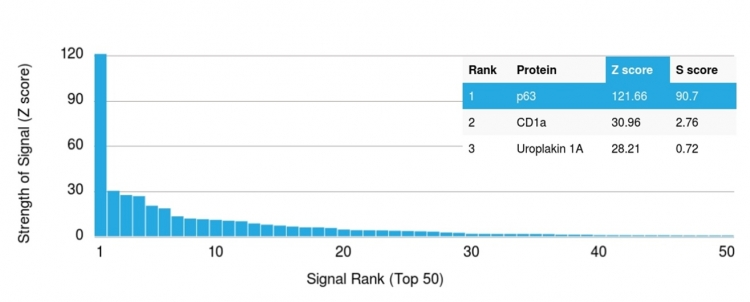
Analysis of Protein Array containing more than 19,000 full-length human proteins using p63 Mouse Monoclonal Antibody (TP63/1786). Z- and S- Score: The Z-score represents the strength of a signal that a monoclonal antibody produces when binding to a particular protein on the HuProtTM array. Z-scores are described in units of standard deviations (SDs) above the mean value of all signals generated on that array. If targets on HuProtTM are arranged in descending order of the Z-score, the S-score is the difference (also in units of SDs) between the Z-score. S-score therefore represents the relative target specificity of a Monoclonal Antibody to its intended target. A Monoclonal Antibody is considered to specific to its intended target if the Monoclonal Antibody has an S-score of at least 2.5. For example, if a Monoclonal Antibody binds to protein X with a Z-score of 43 and to protein Y with a Z-score of 14, then the S-score for the binding of that Monoclonal Antibody to protein X is equal to 29.
p63 antibody [TP63/1786]
GTX34944
ApplicationsWestern Blot, ELISA, Other Application
Product group Antibodies
ReactivityHuman
TargetTP63
Overview
- SupplierGeneTex
- Product Namep63 antibody [TP63/1786]
- Delivery Days Customer9
- Application Supplier NoteWB: 1-2microg/ml. *Optimal dilutions/concentrations should be determined by the researcher.Not tested in other applications.
- ApplicationsWestern Blot, ELISA, Other Application
- CertificationResearch Use Only
- ClonalityMonoclonal
- Clone IDTP63/1786
- Concentration0.2 mg/ml
- ConjugateUnconjugated
- Gene ID8626
- Target nameTP63
- Target descriptiontumor protein p63
- Target synonymsAIS; amplified in squamous cell carcinoma; B(p51A); B(p51B); chronic ulcerative stomatitis protein; EEC3; keratinocyte transcription factor KET; KET; LMS; NBP; OFC8; p40; p51; p53CP; p63; p73H; p73L; RHS; SHFM4; TP53CP; TP53L; TP73L; transformation-related protein 63; tumor protein 63; tumor protein p53-competing protein
- HostMouse
- IsotypeIgG2b
- Protein IDQ9H3D4
- Protein NameTumor protein 63
- Scientific DescriptionThis gene encodes a member of the p53 family of transcription factors. The functional domains of p53 family proteins include an N-terminal transactivation domain, a central DNA-binding domain and an oligomerization domain. Alternative splicing of this gene and the use of alternative promoters results in multiple transcript variants encoding different isoforms that vary in their functional properties. These isoforms function during skin development and maintenance, adult stem/progenitor cell regulation, heart development and premature aging. Some isoforms have been found to protect the germline by eliminating oocytes or testicular germ cells that have suffered DNA damage. Mutations in this gene are associated with ectodermal dysplasia, and cleft lip/palate syndrome 3 (EEC3); split-hand/foot malformation 4 (SHFM4); ankyloblepharon-ectodermal defects-cleft lip/palate; ADULT syndrome (acro-dermato-ungual-lacrimal-tooth); limb-mammary syndrome; Rap-Hodgkin syndrome (RHS); and orofacial cleft 8. [provided by RefSeq, Aug 2016]
- ReactivityHuman
- Storage Instruction-20°C or -80°C,2°C to 8°C
- UNSPSC12352203

![WB analysis of MCF-7, T47D, and MDA-MB453 cell lysates using GTX34944 p63 antibody [TP63/1786]. WB analysis of MCF-7, T47D, and MDA-MB453 cell lysates using GTX34944 p63 antibody [TP63/1786].](https://www.genetex.com/upload/website/prouct_img/normal/GTX34944/GTX34944_20200115_WB_1581_w_23060801_920.webp)
![WB analysis of recombinant p63 protein, PC3, and HeLa cell lysates using GTX34944 p63 antibody [TP63/1786]. WB analysis of recombinant p63 protein, PC3, and HeLa cell lysates using GTX34944 p63 antibody [TP63/1786].](https://www.genetex.com/upload/website/prouct_img/normal/GTX34944/GTX34944_20200115_WB_1865_w_23060801_778.webp)